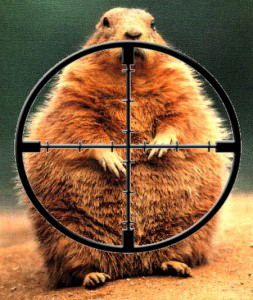Groundhog Day is Friday. Will Phil see his shadow?
Groundhog Day is Friday. Will Phil see his shadow?

It's that time of year again when meteorologists graciously step aside to let a furry rodent make its famed weather forecast.
Punxsutawney Phil, the world's celebrity groundhog, will be coaxed from his burrow in western Pennsylvania early Friday as an anxious nation watches to find out whether we'll have an early spring or six more miserable weeks of cold and snow.
According to legend, if it's sunny and Phil sees his shadow, the scared groundhog returns to his burrow and the U.S. will endure six more weeks of winter. But if it's cloudy when the groundhog emerges on Feb. 2, the critter won't see his shadow and will leave his burrow, meaning winter will soon end and an early start to spring is coming.
According to the National Weather Service, the forecast for Friday morning in Punxsutawney, Pa., calls for cloudy skies and a chance of snow showers, but Phil is a fickle fuzzball, so who knows what he'll do?
The Climate Prediction Center, in its official forecast for February released Wednesday, calls for warmer-than-average temperatures in the western and southern U.S. but cooler-than-average temperatures across the north-central and northeastern U.S.
Unfortunately, based on past weather data, "there is no predictive skill for the groundhog during the most recent years of the analysis," according to a report released this week by NOAA's National Centers for Environmental Information in Asheville, N.C.
Flipping a coin might be as accurate as Phil. Since 1988, the groundhog was "right" 14 times and "wrong" 16 times. In other words, only 14 times did the national average temperature for the remainder of February match what would be expected based on what the groundhog predicted.
Phil was wrong last year: The fuzzy rodent saw his shadow, so there should have been six more weeks of winter. But both February and March ended up warmer than average across the nation, NOAA said. February 2017 was the second-warmest February on record.
Since 1887, the groundhog has seen his shadow 103 times, to forecast a longer winter, and not seen it 18 times, to predict an early spring. (There is no record of the prediction for 10 times in the late 19th century.)
While Groundhog Day is just some mid-winter fun, climate records say that winter probably isn't over, according to NOAA. Climatologically speaking, the three coldest months of the year are December, January and February, so winter typically still has a ways to go when the groundhog comes out on Feb. 2.
Although Phil is the most famous hog, other furry forecasters include West Virginia's French Creek Freddie, Georgia's Gen. Beauregard Lee, Ohio's Buckeye Chuck, North Carolina's Sir Walter Wally, Louisiana's Cajun Groundhog, Alabama's Smith Lake Jake, Wisconsin's Jimmy and New York's Staten Island Chuck (full name: Charles G. Hogg).
Groundhog Day's origins lie in an ancient European celebration of Candlemas, which is a point midway between the winter solstice and the spring equinox — the exact midpoint of astronomical winter.
Superstition has it that fair weather predicted a stormy and cold second half to winter, as noted in this Old English saying:
"If Candlemas be fair and bright,
Winter has another flight.
If Candlemas brings clouds and rain,
Winter will not come again."
If you would like your post to be resteemed for more people to see it, check out this post and follow the steps:
https://steemit.com/resteem/@average-joe/6wmfwn-free-resteem-get-your-post-resteemed-for-more-rewards
Please be sure to follow me, let me know that you followed me and I will follow you back.
He better not or else...